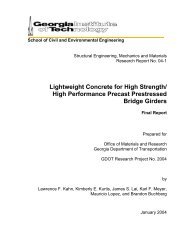Special-Uses-Alkali - Expanded Shale & Clay
Special-Uses-Alkali - Expanded Shale & Clay
Special-Uses-Alkali - Expanded Shale & Clay
Create successful ePaper yourself
Turn your PDF publications into a flip-book with our unique Google optimized e-Paper software.
1. INTRODUCTION1.1. BackgroundRecent changes in the Environmental Protection Agency’s (EPA) regulations on air pollutionhave limited the supply of Class F fly ash acceptable for use in concrete pavements. TheColorado Department of Transportation (CDOT) currently specifies either 10-30% replacementof cement with Class F fly ash or 10-20% replacement with Class C fly ash. Contractors havefound it increasingly difficult to obtain Class F fly ash for projects. CDOT currently has nospecifications for using Class N fly ash. Class N is classified either as a raw or calcined naturalpozzolan that complies with the applicable requirements for this class of materials includingdiatomaceous earths; opaline cherts and shales; tuffs and volcanic ashes or pumicites, calcined oruncalcined; and various materials requiring calcination to induce satisfactory properties, such assome clays and shales. In the past, Class N fly ash has been difficult to obtain, and moreexpensive than Class F fly ash. The CDOT wants to determine if other materials such as naturalpozzolans could be used. A plant in Idaho is planning to start the production of Class N fly ash,as well as several other metakaolin suppliers, giving contractors a viable alternative to Class Ffly ash.Metakaolin is a processed calcined-clay pozzolan classified as a Class N fly ash by requirementsof the American Standard for Testing Materials (ASTM) C618-05 Coal Fly Ash and Raw orCalcined Natural Pozzolan for Use in Concrete. Because metakaolin is a pozzolan, it will provideincreased workability, just as Class F fly ash. Based on this pozzolanic property, CDOT wishesto evaluate the effectiveness of metakaolin in mitigating ASR in concrete..1.2. Scope and Objective of the StudyThis study has several key elements. First, a literature review was performed to find research onClass N fly ash. Second, other state departments of transportation (DOTs) were contacted todetermine if Class N fly ash is used and how it is specified. Third, laboratory tests wereconducted to determine the effectiveness of Class N fly ash and other materials in mitigatingASR when compared to Class F fly ash. Using one source of Class F fly ash, one source of ClassN, and one source of reactive aggregate (fine and course), the effectiveness of Class N wasdetermined by testing each combination in accordance with Colorado Procedures CP-L 4201 and1















